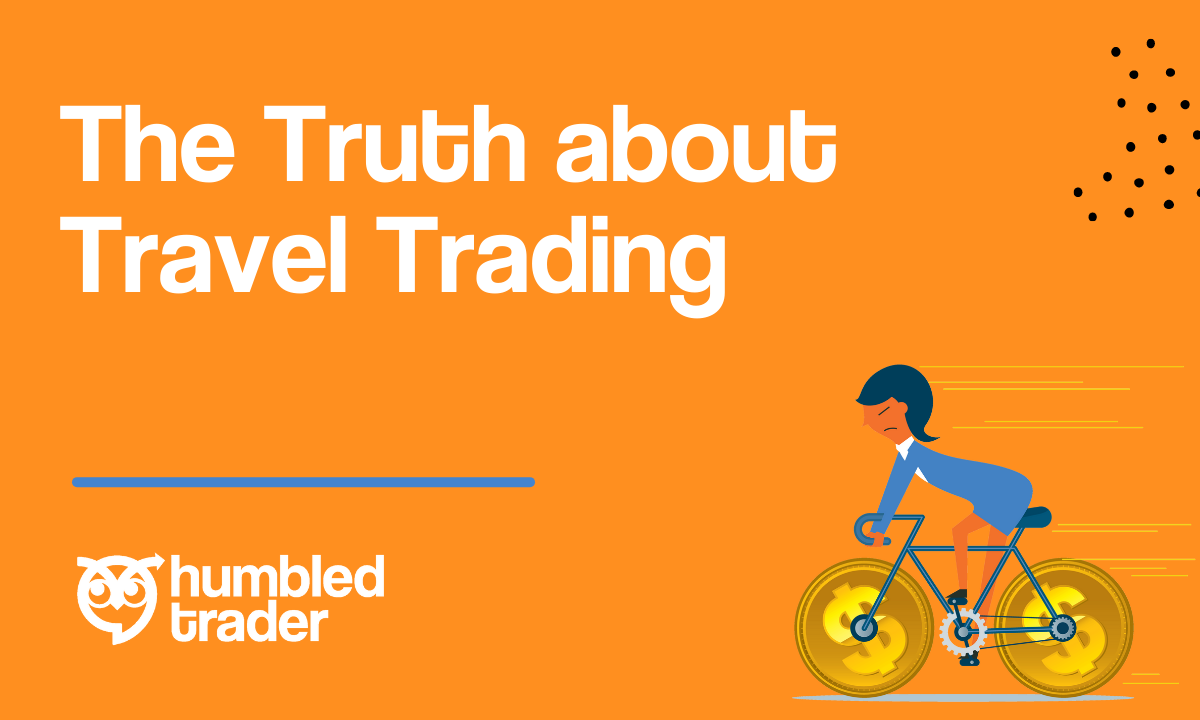How to Start a Day Trading Career Full-Time

Are you thinking of a career change? You may have seen some Lambo ads online and decided to give this Day Trading career a try.
2020 and 2021 were definitely two very interesting years for the stock market. Because of what was going on around the world, more and more people have been drawn to day trading to supplement their income or have been trying out day trading as a potential career to go into full-time
I’ve been day trading for over 7 years now. And let me tell you, starting this career is definitely not as easy as just downloading Robinhood, depositing $100 and clicking buy buy buy as you get ready to bank on the moon.
I wish it was that easy. In this article, I will be sharing with you 4 important steps to start your day trading career. It’s definitely a process that takes a lot of planning in advance in order to make this big move, the right way.
Keep Your Current Job
Alright, the first step to starting your day trading career is to keep your current job. This is a very important foundation to everything we are building here. Please don’t quit your job right away to day trade. It doesn’t matter whether you are working part-time or full-time or whether you hate your boss, your colleagues or your job… please just keep your job.
You will need this income to sustain yourself for the next 6 months or next year while you start day trading. Having that stable income that you can count on will provide you the mental comfort to take trading slowly and allow yourself to actually learn the foundation of risk management and all the trading strategies.
Many people make the mistake of quitting their job cold turkey and just bet 100% on the fact that they could start living off day trading right away after seeing some get-rich-quick schemes online. Unfortunately, if you do that as a new trader, you would be putting an end to your day trading career before you’ve even started.
Keep in mind, just because you can download a day trading app like Robinhood in 2 minutes, that doesn’t mean you can start making money day trading in 2 weeks or 2 months.
Yes, it may be torture going to that job you hate for another 6 months; trust me, I’ve had to do that too. Believe me when I say the short term sacrifice is very much worth the long term reward.
Start Learning to Day Trade
Now that we have step one out of the way, let’s move on to step two, which is to actually start learning to day trade. I’ve done many videos on this topic before… on exactly what beginning day traders should do to focus on when starting to day trade from scratch, but let me summarize it really quickly here rapid-fire style.
Practice the Basics
First, you need to start trading with a paper trading account first at brokers such as Thinkorswim, Interactive Brokers, or Webull. Don’t risk your hard earned money right away.
Then, while practicing on that simulated trading account, start learning about charting, technical analysis and all the basics of buy and sell stocks with free resources online.
Don’t forget to track and journal your trading results in the meantime. It doesn’t matter whether it's paper trading or not. It’s important for any day traders to understand their edge. And to understand what kind of trading strategies and risk profile is best suited for their own trading accounts.
Join a Community
Once you’ve spent a few weeks or a few months paper trading while learning from free resources, if you decide that day trading is indeed something you want to start focusing on seriously, then and only then, is it time to enroll in a structured day trading education program such as the Humbled Trader Academy.
You cannot build a roof on your house until you’ve had a solid foundation, just like you cannot start scaling up in trading unless you’ve really learned how to implement risk management, stock analysis and tracking your data on various trading strategies
If you want to learn the details about each of those steps about how to start day trading as a complete beginner, I’ve actually done a dedicated video on that. Feel free to watch that video later on my youtube channel.
Track Your Personal Finances
Now, let’s move on to the third step. This is perhaps one of the most important steps to transition to day trading full-time, and that is to start tracking your personal finances.
Since the goal is to eventually quit your current job for a career change, it’s important to calculate your monthly expenses and figure out exactly how much money you need to save up in order to live comfortably for at least 1 year after you quit your job, without relying on day trading income.
Do you know how much you should allocate for rent, food, utility and any transportation cost? Are you tracking all the money you bring in each month from your job and all of your expenses paid in cash or credit cards?
I know many people can geek out about excel spreadsheets and those complex graphs and crap like that, but not me. I see an excel spreadsheet and that immediately triggers a headache.
Budget and Expense Tracker
Personally, I like to streamline everything and make it as friction-free as possible. I use a free personal budget & expense tracker like Mint by Intuit to track all of my expenses each month. Once there, I just connect the app to my credit cards, and bank accounts.
Then the website automatically updates all the spending and categorizes everything for me on a weekly basis. The only form of payment they cannot track is payment by cash. That would require manual input by the user. For that reason, I never pay anything in cash anymore.
There are many other websites or apps out there that allow you to track your personal spending. It doesn’t matter whether you use an automated tracking system like I did or an excel spreadsheet DIY style, as long as you do whatever works easiest for you to really categorize all your spendings. From thereafter is where we can optimize the figures.
Personal Budget (Monthly)
I remember around the time I was preparing to quit my job to go full-time day trading many years ago my expenses were as follows:
Each month I was spending about $800 on rent, $200 on going out to restaurants, $150 on groceries, $100 on gas, $200 on a car lease, $100 on a student loan payment and around $200 per month for miscellaneous expenses that may come up by surprise.
That adds up to about $1,750 per month of monthly living costs. Keep in mind, this was more than 6 years ago. That’s why all the figures here sound way too cheap to be true. Take into consideration inflation each year. Now that’s probably around $2,000 per month in 2022.
It also helped that I was single and in my early twenties just graduated from college. Life was just simpler back then, and I had no kids… and eh, I don’t think anyone would be that surprised if I just slept on a mattress on the floor.
Hey, I was into this minimalism thing many years ago, before it became cool in 2021.
Yes, rent was only $800 for me living in the city, because I was living in a two-bedroom apartment with two other roommates. If you want to save up money to build a runway for yourself to switch to full-time day trading, you gotta do whatever it takes.
Personal Budget (Yearly)
Now, we have the monthly expenses figure of $1,750, we can find the one-year living expense cost. $1,750 times 12 equals $21,000. Now, just to be safe, I rounded the figure to $25,000 in order to leave some cushion in my budget.
If you follow all the steps we just talked about by tracking your monthly expense categories, then you should be able to calculate your personal one-year living cost figure to save up in your bank account.
Note that I said to keep those savings in your bank account, not in your trading account. You shouldn’t day trade with the money that is intended for you to live on for the next 12 months, because that would be extremely risky.
The reason for keeping your living expenses outside of your trading account is exactly the same as why we needed to keep that stable income source from your job in the first place. This way you don’t have to rely on trading to pay for food and rent right away.
Having that 12-month financial runway tucked away in your bank account safely, without the risk of market volatility, and risk of well… dumb human decisions will give you a better sense of security and insurance.
Let’s be real, we as day traders do stupid emotional things sometimes. The only way to keep our cool and follow our risk management and trading plans is to be able to detach ourselves from the money and keep our losses small.
So $25,000, this was the figure I needed to save in my bank account from my working income before I can actually quit my 9-to-7 job to go day trade full-time.
You may be looking at your own numbers now and thinking that this is impossible and that you’ll never get there, but every single bit added up.
To save that $25K, I cut back on going out to eat, food deliveries, alcohol and partying. I cooked at home more, terminated my car lease at the time and started taking public transit or riding my bike to work.
I also sublet my parking spot to other renters to make another small source of income for an extra $100 a month.
On top of that, I also took up more overtime work on evenings and weekends. I also worked on statutory holidays, so the pay would be 1.5 to 2x more. I sold a lot of clothes and electronics.
I opened bank accounts that offered $100 or $200 bonuses when you are a new customer, and just put my living expense fund in and out. I had many other side hustles as well.
Seriously, be proactive, and if you want this day trading career bad enough, you will find a way. If this budget tracking and the saving thing sound like too much hassle… then I guess don’t day trade. Just buy and HODL, as the cool kids say.
Quit Your Job
Now, if you’ve gone through steps 1 to 3, you’ve been learning day trading from free and premium resources, tracking your trades, becoming profitable over time, and you have your 1-year living expense saved up. Now, it’s finally time for the fun part.
Go up to your boss in the office, and stick it to…
Okay just kidding. I don't condone that kind of dramatic exit. I like to keep things low-key. Also, I do suggest making sure you can still go back to this job as a backup plan in case day trading doesn’t work out.
Again, the same idea applies as the reasons behind saving one year of living expenses outside of your trading account. Everything here is to provide you some emotional security so you won’t have to start your full-time day trading career under pressure.
Before I officially quit my job, I would take small time off breaks, such as taking the middle of the working week off for 2 days and sometimes up to 5 days. During those two days off, I would wake up and go through the day as if I was already day trading full-time.
This way I could fully experience the routine of waking up early, planning for trades pre-market and trading at open, mid-day and power hour. I saw if I really liked the lifestyle I was striving towards.
I would use my limited vacation time for this, but I think these little experiments were very worth it. The mini full-time trading days really served as a motivation for me to keep grinding with my day trading journey and save up my living expenses at the same time.
This entire process of planning to quit my job and go full-time day trading took a good one year and a half to prepare, if not more.
Conclusion
Like I said at the beginning of this article, just because it’s easy to download a day trading app in 2 minutes doesn’t mean you can start a day trading career in 2 days or even 2 months.
I read this amazing quote online, and it’s one that resonates with me still to this day. “Learning to trade means living a few years of your life like most people won't, so that you can live the rest of your life like most people can't.”
Like I mentioned earlier, it all comes down to sacrifices. Do you want this bad enough? Maybe it means partying a little less on weekends, eating out only once or twice a week, sleeping only six hours a day, and keeping only one boyfriend.
Day trading is a difficult journey, but certainly one that could be very rewarding. I hope the process I described in this article can help you prepare for a career in day trading full-time
If you’re interested in learning more about my trading strategies and especially risk management, feel free to check out the Humbled Trader Academy on my website. Thank you!
Don’t feel like reading? Watch the video.




